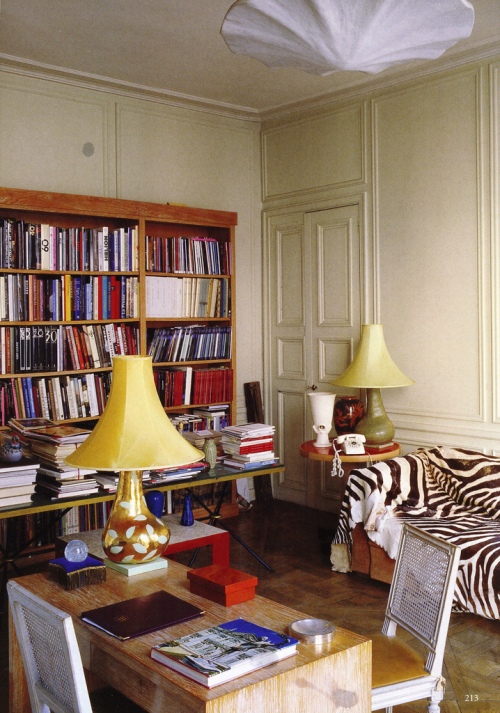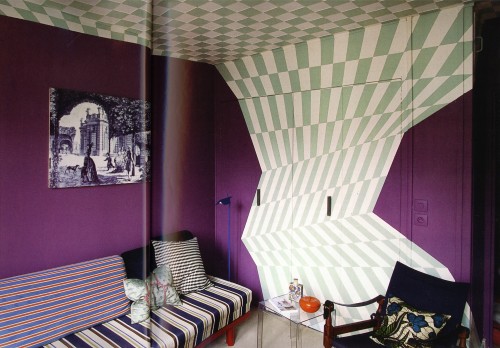You know the feeling of being ill and just wanting to sleep but slightly too ill to actually fall asleep? Then somehow things get worse and you feel as if you’ve been put in a washing machine with that feeling? Maybe the washing machine part is just me. In any event, I can tell you with certainty that it really helps to have a pile of magazines in there for when you get tired of your books.
girl at magazine stand (Pittsburgh, 1947) via ThePulp.Net
Here are some of the magazines piled up by my bedside this week. It’s more of an electronic pile rather than an actual pile because there aren’t many interesting ones in print right now, are there?
Night and Day. A very short-lived English magazine published weekly between July and December of 1937, thankfully available in anthology form. (Also thankfully far more suitable for dragging to bed than my beautiful but slab-like Flair anthology). I suspect most who come to Night and Day do so out of affection for its editor Graham Greene, but my reading habits are sadly under-Greened and I learned of it while poking around Corvo biographer A.J. Symons, who also happened to be their restaurant reviewer. Their contributors! Graham Greene did the film reviews and Evelyn Waugh the book reviews; John Betjeman had a regular feature; Alistair Cooke and Anthony Powell reported on what was happening in America; and there were theater reviews from Elizabeth Bowen, short stories from V.S. Pritchett, and memoirs from Christopher Isherwood. Also William Empson on his efforts to learn Chinese, and, most thrilling for me, Herbert Read regularly reviewing detective novels. I admire The Green Child enough to be delighted with his reviews just for their curiosity value, but he’s actually quite funny.
Night and Day was staggeringly New Yorker-ish, deliberately and admittedly so. Christopher Hawtree’s introduction to the 1985 Chatto & Windus anthology notes that two years prior to the launch of the magazine, Greene wrote, “The world may be divided into those who enjoy Punch and those who enjoy the New Yorker,” while future Night and Day contributor Hugh Kingsmill lamented “[t]here is no critically humorous paper in England today. Nor is there any serious paper which has much, or any individuality.” In Greene’s own preface to the anthology he wrote that “the influence of the New Yorker was very evident during the first months,” though by the time the magazine folded “we were becoming ourselves.” It would be foolish to describe Night and Day as a knock-off; it reflected its own time and place and spoke with its own voice, but the visual resemblance is striking. Not just in the cartoons, which Greene thought superior (“I don’t believe that any paper — even the New Yorker at its best — has obtained the level reached by Night and Day in its comic drawings”) but in familiar little features like the unintentionally funny news clippings that still appear in the New Yorker‘s pages.
Those angels above are not an original cartoon commissioned for the magazine but one of John Flaxman’s illustrations of Dante’s Divine Comedy. The magazine began running them in the July 29, 1937 issue, “[f]eeling that rather less than justice has been done to the distinguished artist who gave his name to a London telephone exchange . . . . As this, after all, is Coronation Year, we have substituted good plain captions in the mother tongue for the unpatriotic quotations from Dante which accompanied the original designs . . .”
One of the things that sunk Night and Day was a libel suit in connection with Greene’s review of the Shirley Temple movie Wee Willie Winkie in the Oct. 28, 1937 issue:
[W]atch the way she measures a man with agile studio eyes, with dimpled depravity. Adult emotions of love and grief glissade across the mask of childhood, a childhood skin-deep. It is clever, but it cannot last. Her admirers — middle-aged men and clergymen — respond to her dubious coquetry, to the sight of her well-shaped and desirable little body, packed with enormous vitality, only because the safety curtain of story and dialogue drops between their intelligence and their desire.
The publishers were fined £3,500 for this “gross outrage,” but the magazine had trouble raising capital well before then, and folded three months before the case went to trial.
I didn’t realize until I started composing this blog post that Night and Day has recently been “reinvigorated and reconceived for a new century” by Vintage Books. I haven’t yet read any of the four issues they’ve put out so far but it looks very promising. I’m particularly happy to see that their contributors include illustrators as talented and stylish as the ones who worked on its previous incarnation. Read and download here.
World of Interiors. The only mag kept in stacks at Lunar Camel Co. Towers. I can’t afford anything in its advertisements, especially the boiseries, I have a feeling, but there’s nothing pretentious about it. It’s a proper magazine with a proper and likable editorial voice. I cannot understand why so many other magazines lack one of those and instead choose to read like an inscrutable catalog of favors to friends and publicists. I suspect it has something to do with people being people, but still.
WoI is full of transporting photos — sometimes rooms, sometimes places like tea processing plants or horticultural supply shops or unglamorized Moroccan farmhouses where cows reside on the ground floor — and unlike other design mags the writing holds up its end of things. I hate flipping through magazines like this and seeing that the book reviews, profiles or arty bits aren’t worth reading.
Designer Eileen Gray’s study, WoI May 2011. For sure my desk needs a lamp with a stomach and a hat. These are by Garouste and Bonetti.
Bricks from a Dec. 2011 WoI feature on historical paints. Sometimes while trying to sleep I mentally paint my bedroom the 1960s blue at the bottom, Capri SC345 from Paper and Paints.
16th-century Wunderzeichenbuch depicting cosmic events from WoI Oct. 2010. The kooky rainbow at left was observed in Vienna in 1520.
Detail above mantle at an auberge in Barbizon favored by 19th-century painters from WoI Jan. 2012.
Textile design by Atelier Zina de Plagny (late 40s / early 50s) from WoI Oct. 2010. de Plagny’s designs have been revived by Surface View.
Purple room from WoI Oct. 2010. It’s a reader’s room submitted for a contest, and the checkered doors hide a kitchen.
Viva, the international magazine for women. Verrrry 70s. I have a small collection of these that sadly will probably not be added to at this point because they’re getting too expensive. I wrote a little something about it on my food blog a few years ago. Definitely due for a follow-up post or two here; stay tuned.
Knob-twiddlers will be pleased to know that 70s issues of Synapse can be read in their entirety. Via Dangerous Minds.
Bright Lights Film Journal. Reliably terrific writing about cinema.
TONMO, The Octopus News Magazine Online (“Your Octopus, Squid and Cephalopod Information Center”). Some animals are better company than others. Frankly I don’t care about squid much, but octopuses are brilliant and mysterious and make for good reading. Related material for aficionados: Poulpe Pulps, “hard-to-locate images of science fiction, fantasy, and adventure pulp and comic covers featuring the wily octopus.”
ARTHUR magazine was so cool. It’s been linked to on my links page forever but maybe you haven’t seen it.
The Modernist Journals Project. This has probably made the rounds of the in-boxes and blogs of everyone who is interested, but: Brown University and the University of Tulsa have a joint project cataloging modernist journals. You can peek at the contents of some of them here.


























